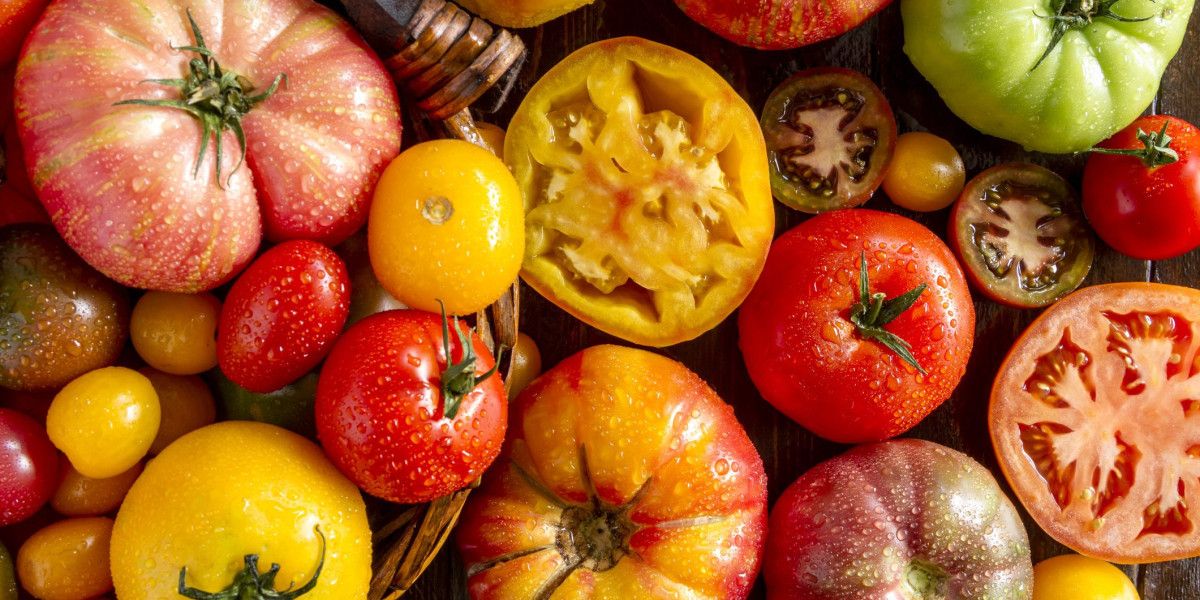You've been misled if you think all tomatoes are created equal - in reality, they come in a stunning array of shapes, sizes, and colours, each with its own unique characteristics that set it apart from the rest.
The notion that uniformity equals quality is a myth perpetuated by commercial growers who prioritize ease of transportation and storage over flavour and nutritional value.
From sweet and tangy to smoky and earthy, flavours vary wildly between varieties, and nutrient content differs substantially too. As you explore the world of tomatoes, you'll discover a rich tapestry of diversity waiting to be uncovered.
Key Takeaways
- Tomatoes come in diverse shapes, sizes, and colours, each with unique characteristics, debunking the tomato myth of uniformity.
- Heirloom varieties boast irregular shapes and vibrant colours, manifesting their genetic diversity and offering varying flavours and textures.
- Tomatoes have distinct flavour profiles and nutrient content, with sweetness, acidity, and sugar content varying significantly between varieties.
- Growing conditions, such as soil quality and climate, greatly impact the final product's flavour, quality, and nutrient content.
- Tomato colours can indicate nutrient density, with yellow and orange tomatoes often higher in vitamin A and beta-carotene and purple and black tomatoes having deeper, richer flavours.
Debunking the Uniformity Myth
You've likely been led to believe that tomatoes must be perfectly uniform in size and shape to be considered high-quality, but this couldn't be further from the truth.
In reality, tomatoes come in a stunning array of shapes, sizes, and colours, each with its own unique characteristics.
This diversity is a result of the crop's rich genetic heritage, which has been cultivated over centuries.
The notion that uniformity equals quality is a myth perpetuated by commercial growers who prioritize ease of transportation and storage over flavour and nutritional value.
In fact, many heirloom varieties boast irregular shapes and vibrant colours, which are manifestations of their genetic diversity.
By embracing this diversity, you'll discover a world of flavours, textures, and aromas that are simply not found in commercial tomatoes.
Flavor Profiles: A World of Difference
Now that you've got a sense of the amazing variety of tomatoes out there, it's time to talk about what really sets them apart: their flavour profiles.
You'll find that sweetness levels vary wildly from one tomato to the next and that acidity plays a huge role in shaping the taste.
As you explore the world of tomatoes, you'll discover that these differences can completely transform your cooking and eating experiences.
Sweetness Levels Vary
From cherry tomatoes to beefsteaks, tomato sweetness levels vary substantially. Some varieties boast a sugar content of up to 9%, while others remain tart and tangy.
You might be surprised to know that tomatoes' sugar content can range from 2% to 9%, affecting their overall taste and flavour profile.
In taste tests, you'll likely find that sweeter tomatoes have a more intense, fruity flavour, while tart varieties have a more acidic, tangy taste.
When it comes to sweetness, some popular tomato varieties stand out.
For instance, Sungold cherry tomatoes are known for their exceptional sweetness, with a sugar content of around 8%.
On the other hand, Roma tomatoes tend to be more acidic, with a sugar content of around 4%.
Understanding the varying sugar content in tomatoes can help you choose the best variety for your cooking needs.
Whether you prefer sweet and juicy or tangy and tart, there's a tomato out there that's sure to satisfy your taste buds.
Acidity Impacts Taste
As you explore the diverse world of tomatoes, acidity levels emerge as a critical factor in shaping their flavor profiles, with some varieties boasting a tangy zip that awakens your taste buds.
You might be surprised to learn that acidity isn't just about tartness levels but also plays a significant role in flavour enhancement. Tomatoes with higher acidity tend to have a more vibrant, intense flavor, while those with lower acidity can taste dull and flat.
When you bite into a tomato, the acidity kicks in, releasing a burst of flavor that complements the natural sweetness.
This perfect balance is what makes some tomatoes truly exceptional. For instance, cherry tomatoes are known for their high acidity, which makes them pop with flavor in your mouth.
On the other hand, beefsteak tomatoes tend to have lower acidity, resulting in a milder taste.
Nutrient Content: Far From Equal
You might assume that all tomatoes are created equal in terms of nutrient content, but the reality is that some varieties pack a much bigger nutritional punch than others.
Tomato tracking has revealed that different types of tomatoes can have varying levels of essential vitamins and minerals.
For instance, cherry tomatoes tend to be higher in vitamin C and potassium compared to larger beefsteak tomatoes.
Vitamin variance is also evident when comparing heirloom tomatoes to hybrid varieties. Heirloom tomatoes often have higher levels of antioxidants and lycopene, an essential cancer-fighting compound.
Even the colour of the tomato can impact its nutritional value. Yellow and orange tomatoes, for example, tend to be higher in vitamin A and beta-carotene.
The Impact of Growing Conditions
As you explore the world of tomatoes, you'll quickly realize that growing conditions play a huge role in the final product.
You might assume that a tomato is a tomato, regardless of where it's grown, but that's not the case.
The soil quality and climate where your tomatoes are grown can substantially impact their flavor and overall quality.
Soil Quality Matters
Growing tomatoes in poor soil is like trying to build a house on shaky ground - the foundation just isn't there to support a healthy, thriving plant.
You can't expect a robust tomato plant to grow in soil that lacks essential nutrients and has an imbalanced pH level. A soil pH that's too acidic or too alkaline can hinder nutrient absorption, leading to stunted growth and poor fruit quality.
Microbial life is vital to soil quality. Beneficial microorganisms help break down organic matter, making nutrients available to tomato plants.
They also fight off pathogens that can cause diseases. However, poor soil conditions can disrupt this delicate balance, allowing harmful microbes to take over.
To give your tomatoes the best start, test your soil pH and adjust it if necessary. Add organic matter like compost or manure to promote microbial life.
Climate Affects Flavor
Now that your tomatoes have a solid foundation in healthy soil, it's time to ponder how climate affects their flavour profile. The right growing conditions can elevate your harvest from bland to grand.
As you might expect, climate plays a significant role in shaping the taste of your tomatoes.
The microclimate influence of your specific region can impart unique flavour characteristics to your tomatoes.
For instance, tomatoes grown in regions with high temperatures and low humidity tend to have a sweeter, more intense flavor.
Conversely, those grown in cooler, more humid climates may have a tangier, more acidic taste.
This variation in flavor is what creates regional flavorprints, making tomatoes from different areas distinct from one another.
Understanding the impact of climate on flavor allows you to tailor your growing conditions to bring out the best in your tomatoes.
Ripeness Matters: Don't Be Fooled
When you're selecting tomatoes, don't let appearance deceive you - a ripe tomato can look surprisingly different from what you'd expect. That's because ripeness is more than just about colour.
Some ways to guarantee you're picking the ripest tomatoes:
Sniff it out: Ripe tomatoes give off a sweet, earthy aroma. If it doesn't have a scent or smells sour, it's likely not ripe.
Check the colour gradation: A ripe tomato will have a slight yellow or orange tint on the underside, indicating it's fully ripe.
Give it a gentle squeeze: Ripe tomatoes will be slightly soft to the touch but still firm enough to hold their shape.
Check the stem: A ripe tomato will have a dry, brown stem that comes off easily. Avoid tomatoes with green or moist stems.
Beyond Red: The Rainbow of Tomatoes
Exploring the vibrant world of tomatoes, you'll discover a stunning array of colours and patterns that go far beyond the classic red.
From sunny yellows and vibrant oranges to deep purples and striking blacks, the rainbow of tomatoes is a true marvel. This diverse palette is a result of careful tomato breeding, where farmers and scientists have selectively cultivated varieties to showcase specific traits.
But what's behind these colourful creations? Colour symbolism plays a significant role, as different hues can evoke emotions and convey flavours. For instance, yellow tomatoes are often sweeter and less acidic, while purple ones may have a deeper, earthier taste.
Beyond aesthetics, these colours can also indicate the tomato's nutritional profile, with some varieties boasting higher levels of antioxidants or lycopene.
As you explore this kaleidoscope of colours, you'll uncover a world of flavours, textures, and stories waiting to be told. So, next time you're at the market, don't be afraid to venture beyond the classic red and discover the true diversity of tomatoes!
Frequently Asked Questions
Can You Grow Tomatoes Indoors Without Direct Sunlight?
You can grow tomatoes indoors without direct sunlight by using artificial lighting like LED grow lights and maintaining ideal indoor temperatures between 65-70°F (18-21°C) for healthy plant growth and fruit production.
How Often Should I Water My Tomato Plants Daily?
You shouldn't water your tomato plants daily; instead, check the soil moisture by sticking your finger in it, and create a water schedule based on that, ensuring the soil's consistently moist but not waterlogged.
Are Heirloom Tomatoes More Prone to Disease Than Hybrids?
Are heirloom tomatoes more prone to disease than hybrids? Well, it's not that simple - disease resistance depends on breeding methods, and while hybrids are bred for resistance, heirlooms can be just as resilient with proper care.
Can I Use Tomatoes That Are Past Their Expiration Date?
You're wondering if you can use tomatoes past their expiration date? Generally, it's not recommended, as it compromises food safety and shelf life. Check for visible signs of spoilage, like mould or sliminess, before deciding to use them. Better safe than sorry!
Do Tomato Seeds Need to Be Soaked Before Planting?
You don't need to soak tomato seeds before planting, but doing so can improve seed viability and boost germination rates. Soaking helps to break down the seed coat, giving your tomatoes a head start on growth.
Conclusion
As you savour the sweetness of your next tomato, remember that each bite bursts with nuances born from diverse flavours, nutrient levels, and growing conditions.
From fiery reds to sunshine yellows, every hue hides a unique personality waiting to tantalize your taste buds.
So, ditch the uniformity myth and delight in the dazzling diversity of tomatoes - a flavorful fiesta that will forever change your salad game!








